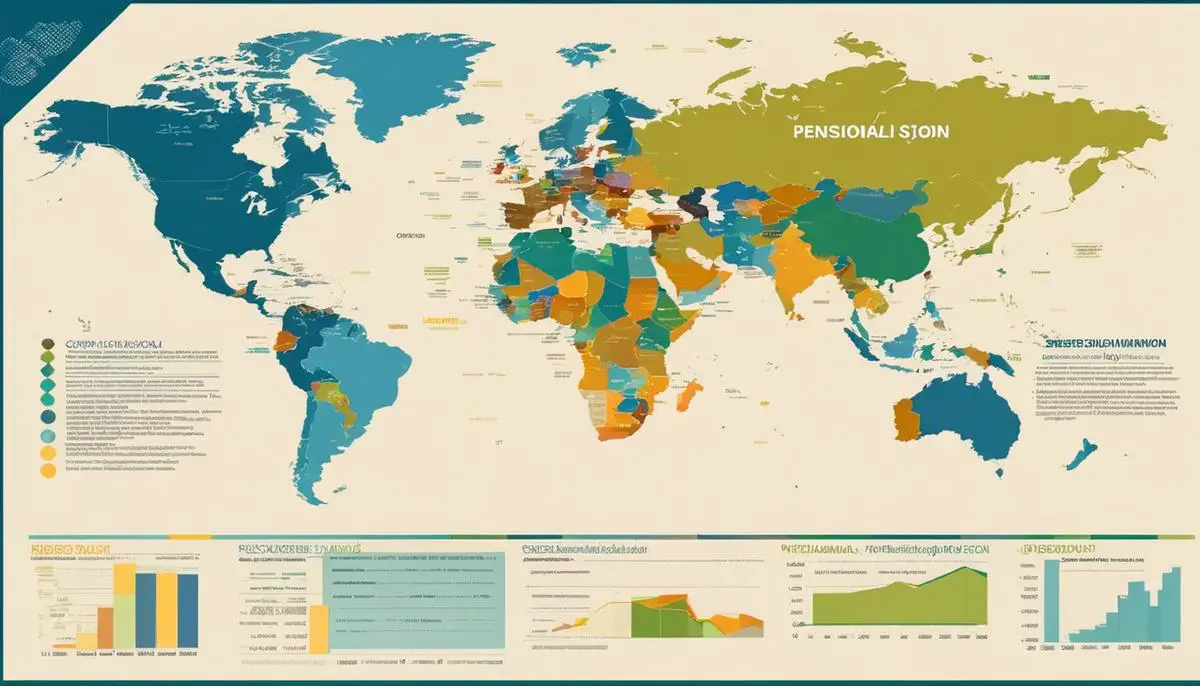Social Security Solvency Challenges in 2024
The viability and future of the Social Security program remains a crucial concern for millions of Americans who depend on it for financial support in their golden years. As debates continue to swirl about the best path forward, understanding the program’s current financial state, along with the factors that could affect its sustainability, is more important than ever. Through a multifaceted analysis of the Social Security Trust Fund’s income, expenditures, and demographic challenges, we will uncover the complex interplay between policy, economics, and an evolving society. Additionally, scrutinizing proposed reforms and international practices offers us a unique window into possible solutions and their broader consequences for American retirees. The vitality of Social Security does not rest on the shoulders of a single generation or policy—it is an interconnected web that spans our collective fiscal and social fabric.
The Current State of Social Security Funds
The Viability of the Social Security Trust Fund: An Examination
The financial health of the Social Security Trust Fund remains a topic of paramount importance within the landscape of American economics and public policy. Established in the 1935 as part of the New Deal, the Social Security Trust Fund was designed to serve as a financial safety net, providing income to elderly Americans, survivors of deceased workers, and the disabled.
As we venture deeper into the 21st century, concerns about the solvency of the Trust Fund have become increasingly pronounced. The primary issue at hand is demographic in nature—the aging Baby Boomer population is retiring in vast numbers, while subsequent generations are smaller and birth rates have declined. This demographic shift results in a higher ratio of beneficiaries to contributing workers, thereby placing augmented financial strain on the Trust Fund’s reserves.
The Trust Fund itself is financed through payroll taxes levied on current workers and their employers. These funds are then allocated to beneficiaries in the form of monthly payments. The excess of funds collected over what is needed to pay current benefits is invested in interest-bearing Treasury securities, theoretically generating income to help sustain the fund’s balance.
However, analysis by the Social Security Board of Trustees has indicated that this model is approaching a critical juncture. As of their 2022 report, the Trustees project that the combined reserves of the Social Security and Disability Insurance funds are likely to be depleted by the year 2035. At that point, incoming payroll taxes are expected to cover only about 80% of scheduled benefits.
This projected deficit is not indicative of an immediate crisis, but it does signal a need for prudent, forward-thinking measures. Potential avenues for remediation include increasing the payroll tax rate, raising the cap on taxable earnings, reducing benefits, or a combination of these approaches. Each solution carries with it complex social and economic implications that necessitate thoughtful dialogue and analysis.
It is crucial to recognize that the Social Security Trust Fund is not an isolated entity; it is deeply interwoven with the fabric of the nation’s economy and the well-being of its citizens. The Trust Fund’s trajectory is affected by diverse factors: employment rates, wage growth, inflation, interest rates, immigration, and legislative reform, among others.
Monitoring the financial health of the Social Security Trust Fund is a vital task that demands rigorous scrutiny. Ensuring the long-term sustainability of the Trust Fund is not merely a technical challenge, but a moral imperative, as millions of Americans depend on its continuance for their economic security. The actions taken today by policymakers will have profound ramifications for current and future recipients alike. As such, the ongoing evaluation and adjustment of the strategies governing the Fund’s reserves is not only a matter of fiscal responsibility but of upholding a social contract with the American people that has endured for generations.

Projected Demographics and Their Impact
Understanding the Interaction Between Demographics and Social Security Systems
The vitality of the Social Security system is closely entwined with population dynamics. As such, it is imperative to analyze how shifts in demographics will impact the solvency of Social Security. Two salient factors—increased longevity and declining fertility rates—have profound implications for the program’s financial viability.
Statistics readily show that Americans are living longer, due in large part to advances in healthcare and health-related behaviors. This rise in life expectancy translates to a greater number of individuals claiming Social Security benefits for a more extended period than was previously projected. This longevity bonus, while a triumph of modern society, necessitates additional financial resources to sustain payouts over longer retirements.
Concurrently, the fertility rates in the United States have been experiencing a significant decline. This trend leads to a reduction in the number of workers entering the labor force. Given that current workers’ payroll taxes primarily fund retirees’ benefits, a shrinking workforce could lead to a shortfall in the contributions crucial for disbursing benefits to retirees. The result of this imbalance is a potential strain on the Social Security system, necessitating a reassessment of the funding model to preserve the integrity of the Trust Fund.
Globalization and immigration also influence demographic shifts, with the latter having the capacity to partially counteract the challenges posed by an aging native-born population. The influx of working-age immigrants can contribute to the payroll tax base, thereby injecting fresh funding streams into the Social Security Trust Fund. Immigration policy, therefore, holds significant sway over the system’s fiscal health.
Another demographic shift of note is the changing pattern of workforce participation, with more individuals pursuing prolonged education and thus, entering the workforce at a later age. Additionally, there is a trend of increasing diversity in the type of employment, with the gig economy and part-time work altering the traditional full-time employment paradigm. These shifts in labor force composition and behavior can affect the amount of payroll taxes collected and the timeline over which they are collected.
Technological advancements and automation also stand to impact the future workforce, potentially altering the number of jobs available and the wages those jobs pay. Such developments could shift the taxable earnings base, thereby affecting the solvency of the Social Security system. The interplay of these multiple forces—technological, demographic, and economic—necessitates ongoing study to discern their cumulative impact on the Social Security Trust Fund.
In conclusion, the solvency of the Social Security Trust Fund is inextricably linked to shifting demographic patterns. An understanding of these patterns allows for strategic planning to mitigate impending challenges. By proactively addressing these issues, it is possible to sustain and fortify the Social Security system, thus ensuring that it continues to serve as an economic safety net for future generations. It is crucial for ongoing research and careful policy consideration to maintain the delicate balance between the needs of the current retirees and the capacity of future workforces to support these needs.

Potential Reforms and Solutions
Understanding the myriad of solutions proposed to secure the Social Security Trust Fund’s future requires a pragmatic approach that collectively addresses the multifaceted dimensions of the issue.
In the quest for a solvent Trust Fund, certain proposals have garnered widespread attention and consensus.
One such strategy emphasizes enhancing revenue inflow by lifting the cap on taxable earnings. Currently, payroll taxes are only levied on income up to a certain threshold. By removing this cap, higher earners would contribute proportionally more to the Trust Fund, thereby increasing the revenue pool.
An extension of the revenue-increasing approach is diversification of the Trust Fund’s income sources, which entails seeking novel revenue channels. Proposals within this category extend to taxation of unearned income and leveraging Federal Insurance Contributions Act (FICA) tax to encapsulate forms of compensation currently exempted, like certain fringe benefits.
Concurrently, proposals have been put forth to tweak the indexation of benefits. Adjusting the cost-of-living adjustments (COLAs) by adopting an alternative measure of inflation, such as the chained Consumer Price Index (CPI), would result in a more accurate reflection of cost changes affecting seniors. This adjustment is expected to reduce outlays incrementally, thereby slowing expenditure growth.
Moreover, a gradual increase in the full retirement age (FRA) is under consideration, predicated on the substantial increase in life expectancy. This adjustment would encourage prolonged workforce participation, consequently boosting the revenue through payroll taxes, as well as mitigating the expenditures due to a shorter span of benefit collection.
In addition, policy reform focused on incentivizing delayed retirement is gaining traction. This involves enhancing benefits for those who choose to retire later than the designated full retirement age, thereby rewarding additional years of workforce participation and contribution.
Another solution involves direct reduction of benefits—it remains the most contentious due to its palpable impact on beneficiaries. However, it is argued that targeted benefit reductions, sparing low-income individuals, coupled with an emphasis on bolstering safety nets for the most vulnerable, could be an equitable way of reducing expenditures.
Preventive policies aimed at bolstering the general economy also hold relevance. By nurturing environments that foster employment and wage growth, the system can indirectly benefit through increased payroll tax inflows.
Supplementing these ideas, a focus on educating the public about private savings and promoting financial literacy can underpin the other methods. Encouraging personal retirement savings can reduce reliance on the Social Security Trust Fund and facilitate individual financial sustainability.
While these proposals are subject to substantial debate and require a balanced analysis of their long-term viability and impact, it is clear that a multifaceted solution combining revenue enhancements, benefit modifications, and broader economic policies will be fundamental to securing the Social Security Trust Fund. As demographic, economic, and technological trends evolve, a dynamic and responsive approach to policy-making remains of utmost importance to safeguard the fiscal health of the Trust Fund, reflecting the innate adaptability required to sustain the pivotal societal pillar that Social Security represents.

Economic Factors and Future Projections
Understanding the Economic Trends Affecting Social Security’s Solvency
The solvency of the Social Security Trust Fund remains a critical concern for policymakers and beneficiaries alike. It is integral to comprehend how prevailing economic trends can influence this solvency, impacting both current and future retirees.
Firstly, we must consider the significance of economic growth. A robust economy boosts employment, thereby increasing payroll tax revenues which are pivotal for funding Social Security. Conversely, a recession diminishes employment and wages, constricting the revenue stream and exacerbating the Trust Fund’s deficit.
Interest rates, set by the Federal Reserve, are another critical economic element. Higher rates can increase the returns on the Trust Fund’s investments in Treasury securities, though parallel forces might decrease overall economic growth and payroll tax receipts, presenting a complex relationship.
Inflation, while typically leading to higher wages and thus greater tax contributions, also necessitates higher cost-of-living adjustments for beneficiaries. Hence, the system could potentially pay out more, counteracting any gains from increased tax revenue.
Furthermore, the federal budget deficit and national debt levels can indirectly influence the Trust Fund. If the government needs to reduce spending or increase taxes to manage its debt, this could decrease available funds for Social Security or necessitate cuts to the program.
Global economic events and trends, such as trade agreements, international debt crises, or worldwide recessions, can ripple through the U.S. economy, affecting employment, wages, and ultimately the inflow and outflow dynamics of the Social Security Trust Fund.
It should also be noted that legislative decisions regarding taxation, welfare, healthcare, and immigration can profoundly shift the economic landscape. For example, tax reforms can alter the disposable income of consumers and the operational costs for businesses, which in turn influences the economy’s performance and the Trust’s financial standing.
In conclusion, Social Security’s solvency is deeply intertwined with the broader economic context. It is sensitive to fluctuations in employment patterns, interest rates, inflation, federal fiscal actions, and international economic activities. As such, a multidimensional approach—involving vigilant economic analysis and cautious policy formulation—is paramount to ensure that Social Security can continue to provide economic security to the millions reliant on its sustenance.

Photo by nishantskul on Unsplash
Policy Debates and Legislative Challenges
Legislative Complications in Enacting Social Security Reforms
Legislation associated with Social Security reform encapsulates one of the most daunting challenges in contemporary policy-making. This arena necessitates a profound commitment to the intricate balance between economic feasibility and ethical responsibility, a balancing act that demands rigorous scrutiny and foresight.
At the nexus of Social Security reform lie the political intricacies. The system is intimately tied to the vicissitudes of the political landscape, where ideology, partisanship, and the divergence of public opinion play pivotal roles. The partisan nature of Congress can lead to stalemates, hindering the passage of comprehensive reform legislation. Policymakers face the arduous task of fostering a bipartisan consensus that transcends political interest in favor of the national welfare.
Further complicating reform efforts is the need to consider intergenerational equity. How does one strike a fair balance between the benefits received by current retirees and the future obligations to younger generations, without placing an undue burden on either? Engaging a diverse array of constituents in a meaningful dialogue is critical to ensure equitable solutions that are both progressive and sustainable.
Public perception and the sensitivity of the subject matter add additional layers of complexity to legislating Social Security reforms. Changes to the system can evoke strong emotional responses, as they directly impact the livelihoods and future security of countless individuals. Effective communication of the underlying fiscal issues and the necessity for reform is imperative to garner public support and alleviate fears of benefit loss or diminution.
Moreover, the execution of reform is entwined with economic predictions and actuarial assessments, which inherently contain a degree of uncertainty. Economists and demographers must continuously project variables like life expectancy, fertility rates, and economic growth with precision. However, slight deviations in these forecasts can significantly alter the long-term outlook of the Social Security system, necessitating ongoing revisions to legislative strategies.
Ethical considerations loom large when discussing Social Security reform. It is vital to approach reform measures with an acute sense of their social implications, particularly in terms of how changes affect the most vulnerable populations. Proposals must be meticulously evaluated to ensure that measures intended to stabilize financial aspects of the program do not inadvertently cause harm or widen existing inequalities.
The navigation through these multifarious challenges connotes that Social Security reform is not merely a technical endeavor but a profoundly moral one. It commands a steadfast dedication to empirically informed and ethically grounded decision-making. There is no singular solution to the labyrinthine challenges of Social Security reform, but a continuous dedication to analysis, adaptation, and principled action is paramount to fostering a system that upholds the promise of security for generations to come.

Global Comparisons and Lessons Learned
The Comparative Analysis of International Pension Systems: Enlightening U.S. Social Security Reform
When considering the trajectory of the United States Social Security system, it is prudent to look beyond domestic strategies and examine pension systems of other nations. Global insights can potentially illuminate pathways for fortifying the fiscal future of the U.S. Social Security Trust Fund.
To begin, one must acknowledge the variety of pension schemes observed internationally, which primarily take shape in three forms: defined benefit plans, defined contribution plans, and hybrid designs. These designs offer various levels of security and risk for beneficiaries and can profoundly affect the stability and adequacy of retirement income.
An exemplary model is found in the Nordic countries, which operate extensive and generous welfare states, combining a basic pension with earnings-related components. The strength of these systems lies in their comprehensive coverage, progressive taxation, and the successful balancing of public and private provisions. Lessons from these countries include the emphasis on universality and the importance of integrating pension policies within a wider social welfare paradigm.
Alternatively, one considers the multipillar system embraced by the Chilean model, introduced in the 1980s, where mandatory individual retirement accounts are supplemented by voluntary savings and a state-funded safety net. Notwithstanding concerns surrounding fee structures and disparities in savings levels, the Chilean approach highlights an avenue where the labor force is actively engaged in personal retirement planning, which in turn, could influence U.S. policy discussions about personal retirement accounts.
Australia’s superannuation scheme, a mandatory employer-funded system expanded by successive governments, offers another informative contrast. Its robustness is due to its mandatory savings component, contributing to high levels of national savings and offering lessons on incentivizing private savings without overburdening lower-income workers.
Similarly, the Japanese system addresses demographic challenges common to both Japan and the U.S. by continuously adjusting the age of eligibility and benefits, underscoring the necessity for flexibility and adaptability in policy design.
These international reflections suggest that the U.S. could benefit from policies that diversify income sources for the Trust Fund, perhaps by learning from the Australian model’s success in mandating saving for retirement. Likewise, the focus on private savings found in the Chilean system could inspire policies to encourage greater individual retirement investments among U.S. workers.
Adjusting the Social Security system parameters, such as retirement age and benefits, as seen in Japan, could also offer a framework for the U.S. to manage similar demographic dynamics. Pivotal considerations include not just the financial viability but also fairness across generations and the distributional effects of any policy changes.
Moreover, the Nordic model suggests the importance of maintaining strong social safety nets and addressing inequality. Enhancing the socio-economic safety of lower-income populations in the U.S. while ensuring the longevity of Social Security requires careful policy crafting and may involve a more integrated approach with other social programs.
International pension models inform U.S. policy by offering a spectrum of innovative and tested solutions to common challenges. Examination of other systems surfaces critical considerations for financial sustainability, social equity, and economic incentives that are pivotal in effectively reforming the U.S. Social Security program. Adopting international best practices within the unique context of U.S. demographics, economy, and political landscape is not just an academic exercise but a practical necessity.

The robust conversation surrounding the future of Social Security is indicative of its significance to American life. The potential solutions and reforms discussed herein reflect a spectrum of pragmatic and political considerations that must be carefully weighed against their long-term impacts on beneficiaries and the economy. While there is no one-size-fits-all answer to the challenges looming over the horizon, the insights gleaned from economic trends, demographic shifts, international experiences, and legislative debates light the path to responsible stewardship. The fortitude of Social Security, as an institution, will test our collective resolve to innovate, adapt, and commit to the wellbeing of current and future generations. The journey from analysis to action beckons, with the promise that conscientious, informed decision-making will sustain and strengthen this cornerstone of our social safety net.



Leave a Reply